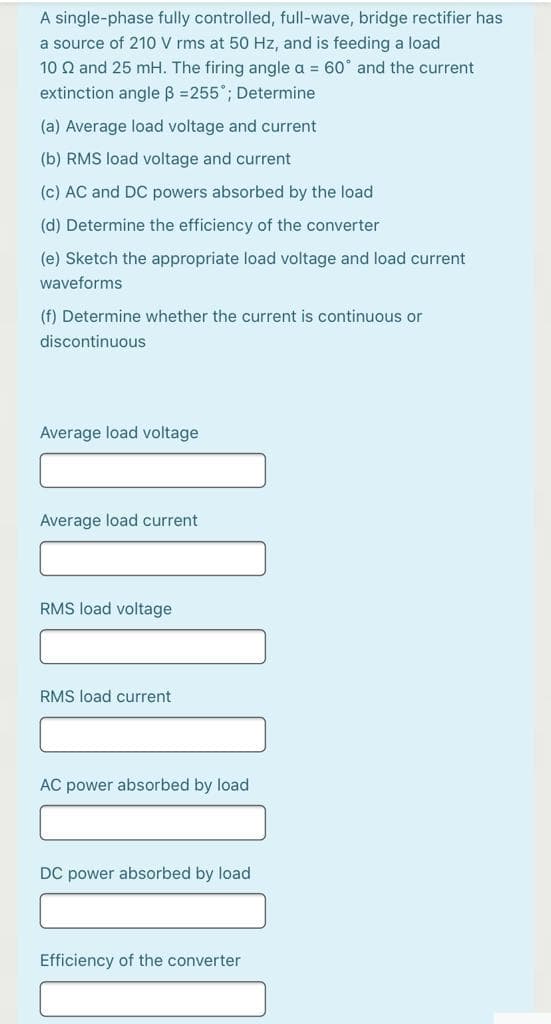A single-phase fully controlled, full-wave, bridge rectifier has a source of 210 V rms at 50 Hz, and is feeding a load 10 Q and 25 mH. The firing angle a = 60° and the current extinction angle B =255°; Determine (a) Average load voltage and current (b) RMS load voltage and current (c) AC and DC powers absorbed by the load (d) Determine the efficiency of the converter (e) Sketch the appropriate load voltage and load current waveforms (f) Determine whether the current is continuous or discontinuous
A single-phase fully controlled, full-wave, bridge rectifier has a source of 210 V rms at 50 Hz, and is feeding a load 10 Q and 25 mH. The firing angle a = 60° and the current extinction angle B =255°; Determine (a) Average load voltage and current (b) RMS load voltage and current (c) AC and DC powers absorbed by the load (d) Determine the efficiency of the converter (e) Sketch the appropriate load voltage and load current waveforms (f) Determine whether the current is continuous or discontinuous
Introductory Circuit Analysis (13th Edition)
13th Edition
ISBN:9780133923605
Author:Robert L. Boylestad
Publisher:Robert L. Boylestad
Chapter1: Introduction
Section: Chapter Questions
Problem 1P: Visit your local library (at school or home) and describe the extent to which it provides literature...
Related questions
Question

Transcribed Image Text:A single-phase fully controlled, full-wave, bridge rectifier has
a source of 210 rms at 50 Hz, and is feeding a load
10 Q and 25 mH. The firing angle a = 60° and the current
extinction angle B =255°; Determine
(a) Average load voltage and current
(b) RMS load voltage and current
(c) AC and DC powers absorbed by the load
(d) Determine the efficiency of the converter
(e) Sketch the appropriate load voltage and load current
waveforms
(f) Determine whether the current is continuous or
discontinuous
Average load voltage
Average load current
RMS load voltage
RMS load current
AC power absorbed by load
DC power absorbed by load
Efficiency of the converter
Expert Solution
This question has been solved!
Explore an expertly crafted, step-by-step solution for a thorough understanding of key concepts.
Step by step
Solved in 2 steps with 2 images

Knowledge Booster
Learn more about
Need a deep-dive on the concept behind this application? Look no further. Learn more about this topic, electrical-engineering and related others by exploring similar questions and additional content below.Recommended textbooks for you

Introductory Circuit Analysis (13th Edition)
Electrical Engineering
ISBN:
9780133923605
Author:
Robert L. Boylestad
Publisher:
PEARSON

Delmar's Standard Textbook Of Electricity
Electrical Engineering
ISBN:
9781337900348
Author:
Stephen L. Herman
Publisher:
Cengage Learning

Programmable Logic Controllers
Electrical Engineering
ISBN:
9780073373843
Author:
Frank D. Petruzella
Publisher:
McGraw-Hill Education

Introductory Circuit Analysis (13th Edition)
Electrical Engineering
ISBN:
9780133923605
Author:
Robert L. Boylestad
Publisher:
PEARSON

Delmar's Standard Textbook Of Electricity
Electrical Engineering
ISBN:
9781337900348
Author:
Stephen L. Herman
Publisher:
Cengage Learning

Programmable Logic Controllers
Electrical Engineering
ISBN:
9780073373843
Author:
Frank D. Petruzella
Publisher:
McGraw-Hill Education

Fundamentals of Electric Circuits
Electrical Engineering
ISBN:
9780078028229
Author:
Charles K Alexander, Matthew Sadiku
Publisher:
McGraw-Hill Education

Electric Circuits. (11th Edition)
Electrical Engineering
ISBN:
9780134746968
Author:
James W. Nilsson, Susan Riedel
Publisher:
PEARSON

Engineering Electromagnetics
Electrical Engineering
ISBN:
9780078028151
Author:
Hayt, William H. (william Hart), Jr, BUCK, John A.
Publisher:
Mcgraw-hill Education,